V. K. Srivastava
Department of Mechanical Engineering, Indian Institute of Technology, BHU, Varanasi-221005, India
Correspondence to: V. K. Srivastava , Department of Mechanical Engineering, Indian Institute of Technology, BHU, Varanasi-221005, India.
| Email: |  |
Copyright © 2012 Scientific & Academic Publishing. All Rights Reserved.
Abstract
The objective of this study is to investigate the impact behaviors of sandwich structures. These sandwich structures are made of cross-plied E-glass fibre reinforced plastic (GFRP) composite faces with polyurethane foam core. GFRP composites are used to combine the upper face and the lower face through the core in stitched sandwich structures. Three impact conditions are considered, such as the Izod impact, Charpy impact and weight drop impact. The results show that weight drop impact energy is higher than the Izod and Charpy impact energy, where as dynamic fracture toughness of charpy impact energy is more than the izod and weight drop impact energy due to geometry of impactor and specimen.
Keywords:
Glass fibre composites, Polyurethane foam, Impact tests, Dynamic fracture toughness
1. Introduction
Non-stitched sandwich structures are made of two stiff and thin faces adhesively bonded to a relatively soft and thick core. In general, the faces carry the principal loads while the inner core acts to transmit the shear loads to the faces and absorbs the strain energy. These sandwich structures are widely used in many industrial fields due to a high flexural property to weight ratio, a high resistance to corrosion, and a good thermal and acoustic insulation. In particular, fiber reinforced composites have been employed for the faces and honeycomb structures are preferred as the core in the design and construction of civil and military applications. Recently, polymeric foams were also adapted as the core in certain industrial applications, where cost in of major concern, such as marine ships, refrigerating containers, and trains[1].Non-stitched sandwich structures are apt to be damaged in the faces and/or the core under low energy impacts. The major modes of failures are delamination between the face and the core, the shear and compressive failures in the core, and the tensile failure in the faces. It has been recognized that these types of damage may reduce the stiffness and the residual strength of the sandwich structures during the service life. In order to overcome the shortcomings of non-stitched sandwich structures, the through-the-thickness reinforcement by a stitching process is one of the solutions for averting delamination between the face and the core, and minimizing the reduction of the stiffness and the residual strength during the impact event. One of the important concerns in the use of the sandwich structures is to identify the susceptibility of damage under low energy impacts[2]. Although much effort has been spent to identify the impact behaviours on non-stitched sandwich structures, little literature on the study of stitched sandwich structures has been available up to now.Caprino et al[3] carried out the low velocity impact test on the sandwich panels and suggested the damage parameter. The experimental results showed that the damage parameter depends only on the impact energy, and the residual strength after the impact of the face can be predicted on the basis of the damage parameter. The major modes of failure included the local yielding in the core, the matrix cracking, and delamination in the face[4]. The dominant failure modes for the sandwich beams involved the upper face failure in the vicinity of the penetrator. The impact performance of the sandwich beams showed the rate dependence effect with the failure energy reducing to a minimum at a given drop height and then increasing with the drop height[5-7].Damage tolerance of such sandwich structures is substantially more complex than conventional laminated structures. Besides typical damage concerns such as through penetration and delamination, additional modes including core crushing and face sheet debonding must be addressed. Often damage may not be characterized as uniform through the thickness. An impact may penetrate or damage only one face sheet while the other remains intact[8, 9]. Manufacturing flaws or in-service loads will also result in an unsymmetrical damage state. Cores tend to absorb and retain water which often reduces mechanical properties as well as increasing the structural weight. To fully realize the weight-saving potential of sandwich structures, one must first understand the damage tolerance of such structures[10, 11]. The objective of this study is to investigate the impact behaviours of sandwich structures. Sandwich structures are made of 0/90o woven fabric E-glass fibre reinforced epoxy resin faces with a polyurethane foam core. The impact energy tests are conducted on the sandwich structures using Izod impact, Charpy impact and weight drop impact testers. The impact responses of sandwich structures are compared and discussed with their energy and fracture toughness.
2. Materials and Experiments
Cross-ply, glass fibre-reinforced epoxy resin composites were moulded by the hand lay-up technique using commercially available E-glass fibre woven mats and a matrix comprising Araldite CY-205 epoxy resin and HY-951 hardener. Fibre volume fraction of laminates was about 46% with average thickness of 3 mm. These composite sheets were used to prepare sandwich structures. Composite sheets were bonded onto the top and bottom faces of polyurethane foam (thickness 12 mm) with the help of epoxy resin adhesive.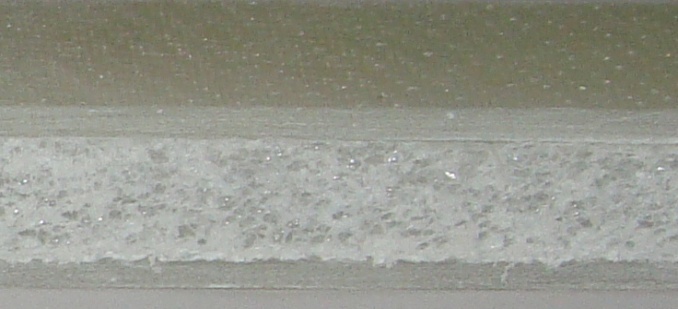 | Figure 1. .Sandwich structure of GFRP- polyurethane foam-GFRP |
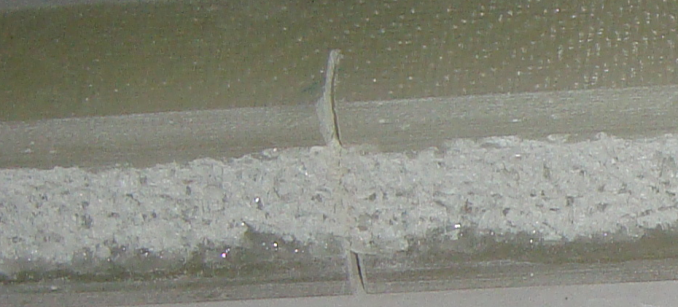 | Figure 2. Notched GFRP-foam-GFRP composite |
Fig.1 shows the configuration of stitched sandwich specimens used for this study. All the sandwich specimens were 250 mm in length, 200 mm in width and 18 mm in thickness. Notch and un-notch Izod and charpy impact specimens were cut from the sandwich structure. The dimensions of Izod impact test are length 66 mm, width 20 mm, thickness 18 mm. Charpy impact test dimensions are length 123 mm, width 20 mm and thickness 18 mm respectively. The specimen size of weight drop test is length 45 mm, width 45 mm, and thickness 20 mm. The depth of V-notch is introduced 2 mm in Izod and charpy impact test specimens, as shown in Fig.2.The impact test was performed with instrumented Izod and Charpy equipment (Model; Resil Impactor-50, CEAST, S. p. A., Italy). The impact hammer and vice lever with specimen adapter were used different in Izod and charpy impact tests. The impact length and impact velocity were 0.327 m and 3.46 m/s. Izod and charpy impact tests were performed on notched and un-notched sandwich specimens. The impacted specimens were shown in Figs. 3 & 4.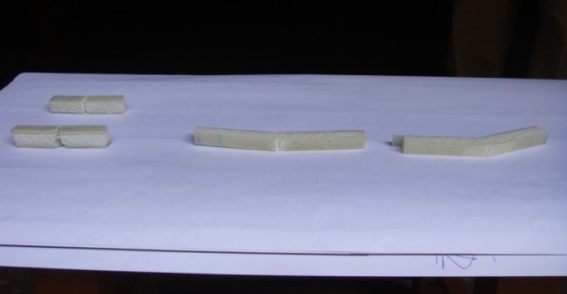 | Figure.3. Fractured specimen under charpy impact test |
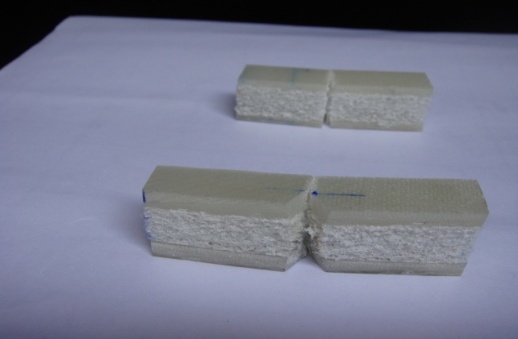 | Figure 4. Fractured specimen under Izod impact test |
The test comprised dropping a mass of 0.932 Kg on the specimen through specified heights by an impact machine. The mild steel impactor (striker) was designed with a spherical shaped end of 31 mm diameter to simulate non-deforming projectiles. The sandwich specimen was placed on a flat surface of thick plate to avoid bending, and the striker was dropped at height of 176 cm.The surface of the specimen developed scattered cracks due to the impact from the striker, as shown in Fig. 5 (a & b). The impact energy was obtained from the height dropped. The results of each type of test were measured with the average values of five specimens.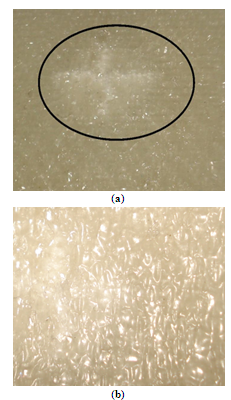 | Figure 5. Fractured under weight dropt test. (a). cracks propagated through top to inner face and (b) foam core debonded and pull out from composite |
3. Results and Discussion
Low energy impact tests were conducted to investigate the impact behaviours of sandwich structures. Izod, charpy and weight drop impact tests were used and impact energies were considered. Five specimens were tested in each category. The average values of impact test results of sandwich specimen are presented for comparison. The energy absorption behaviour under low velocity impact testing is shown in Fig. 6. 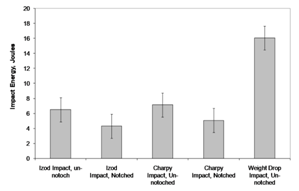 | Figure 6. Impact behavior of sandwich GFRP- polyurethane foam-GFRP structures |
The result shows the weight drop impact energy gives higher values than the Izod and charpy impact energy with the variation of the impact tests and sandwich structures. The notched specimens showed a tendency of decreasing impact energy under izod and charpy impact tests. When the sandwich structures are impacted with the izod and charpy impactor, the impact energy is localized along with the thickness of the specimen and sandwich structures fractured from the impactor point, due to the dominant flexural behaviours[7]. Whereas, sandwich specimen is impacted with weight drop spherical impactor, the impact energy is uniformly distributed along the width of the specimen. The local deformation in the case with the spherical impactor is damaged only the front face of composite (Fig.5a) and energy not transferred on the back side of the composite face because foam absorbed the impact energy[4,6]. Low energy impacts can incur damage, which is hard to detect by visual inspection. However, at certain energy level, when delaminations are formed in the composite face the impact damage area is visible and can be estimated using quantitative image analysis[9]. Fig. 5a & b shows the top face of the composite specimen after impact. It was found that, core crack was followed by face sheet debonding, accordingly damage area consists of delamination in the face sheet and additional debonding at the upper face/foam interface, as shown in Fig. 5b. The given level of the impact energy is sufficient to damage the sandwich specimen.Dynamic fracture toughness (αk) was calculated using the following equation[9], | (1) |
where ΔE is the absorbing energy of material during impact processing, w and h are the width and thickness of specimen, respectively. 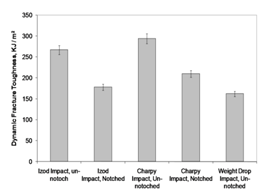 | Figure 7. Dynamic fracture toughness behavior of sandwich GFRP- polyurethane foam-GFRP structures |
Fig. 7 indicates the variation in dynamic fracture toughness with the impact tests. The result shows the dynamic fracture toughness under charpy energy is more pronounced than the izod and weight drop impact energy. Weight drop impact energy gives lower dynamic fracture toughness compare to charpy and izod impact energy, which may result from vibrations of the supports and initiation of damage in the materials[10].The differences observed in the interfacial region of the specimens affect impact damage size. Both faces of sandwich specimens fractured under izod and charpy impact energy, while weight drop impact energy fractured only top face of sandwich structure, as can be identified by Figs. 4 & 5. This shows the good mechanical resistance which prevent formation and transformation of cracks from top face to back face, because, foam core absorbed the maximum energy. The change of the impactor’s momentum as it passes through the specimen relates to the energy consumed by the fracture process. The velocity of the impactor becomes zero when the sandwich structure reaches its maximum deflection[11]. During the izod and charpy impact tests, top and bottom faces of GFRP composite became fully penetrated. As a result, the foam core was also fractured in a different plane as shown in Fig.8. 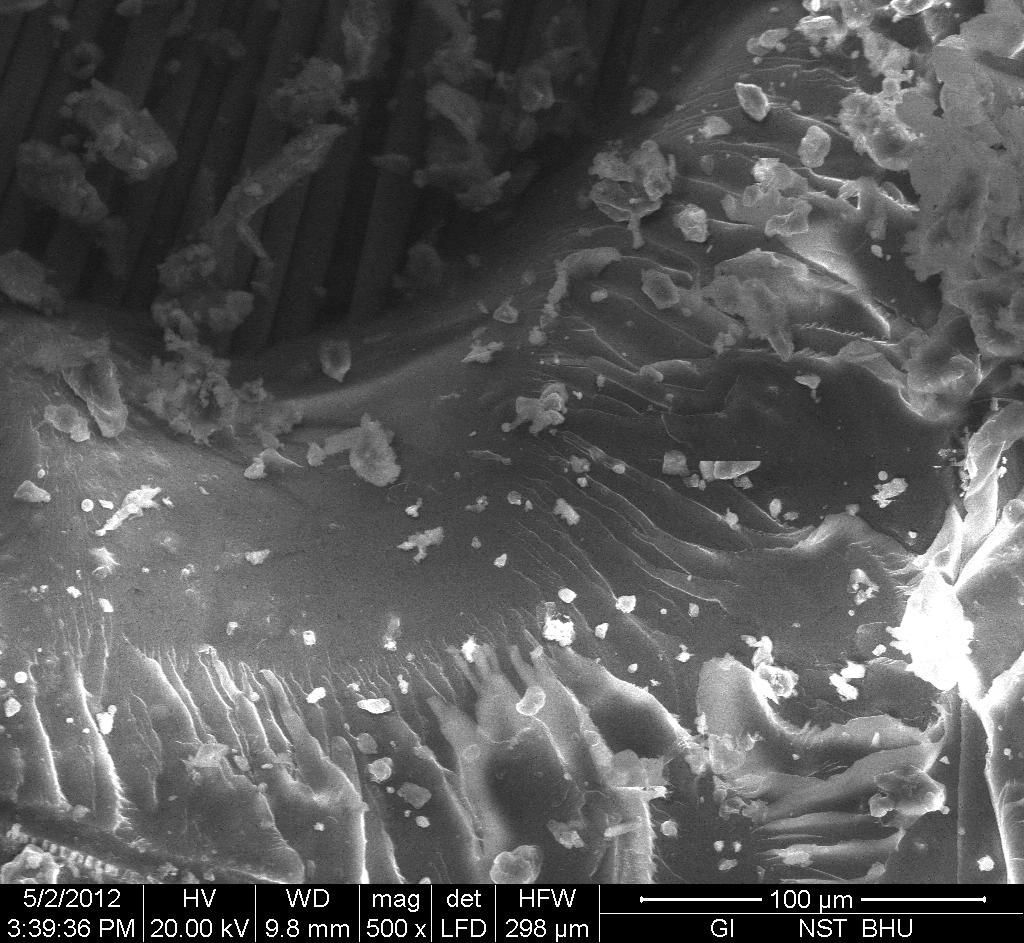 | Figure 8. SEM images of fractured surface |
Due to its brittle nature, the sandwich specimens were completely fragmented after being subjected of 7.14 J (Charpy) and 6.5 J (Izod) incident energies. A noticeable difference between notched and un-notched sandwich specimens was found in incident energy. This trend confirms that the impact energy depends on the geometry of specimen due to dissipation of impact energy by the impacted specimens[5].
4. Conclusions
An investigation has been conducted to study the effect of impact tests on sandwich GFRP- polyurethane foam-GFRP specimens. Significant variation in energy absorption was found under Izod impact, Charpy impact and weight drop impact conditions. The experimental results suggest that the charpy impactor reveals high dynamic fracture toughness compare to Izod and weight drop impactors.
ACKNOWLEDGEMENTS
The author would like to thanks Mr. Kali Prasad, Sr. Mechanic, Mr. R.P. Singh, Laboratory Attended, Department of Mechanical Engineering, Indian Institute of Technology, BHU, Varanasi, India for their supports.
References
| [1] | Wu CL, Sun CT. Low velocity impact damage in composite sandwich beams. Compos Struct 1996;34:21-27. |
| [2] | Mines RAW, Worral CM, Gibson AG. The static and impact behavior of polymer composite sandwich beams. Composites 1994;25:95-110. |
| [3] | Caprino G, Teti R. Impact and post impact behavior of foam core sandwich structures. Compos Struct 1994;29:47-55. |
| [4] | Nemes JA, Simmonds KE. Low velocity impact response of foam core sandwich composites. J Compos Mater 1992; 26(4);500-519. |
| [5] | Mitrevski T, Marshall IH, Thomson R. The influence of impactor shape on the damage to composites laminates. Compos Struct 2006;76:116-22. |
| [6] | Abrate S. Localized impact on sandwich structures with laminated facing. ASME Appl Mech Rev 1997;50:69-82. |
| [7] | Evci C, Gougec M. An experimental investigation on the impact response of composite materials. Int J Impact Engine 2012; 43:40.51. |
| [8] | Kang TJ, Lee SH. Effect of stitching on the mechanical and impact properties of woven laminate composite. J compos Mater 1994;28:1574-87. |
| [9] | Naik NK, Skher YC. Damage in laminated composites due to low velocity impact. J Reinforced Plast 1998;17:1232-63. |
| [10] | Bull PH, Edgren F. Compressive strength after impact of CFRP foam core sandwich panels in marine applications. Composites Part B 2004;35:535-41. |
| [11] | Rohchoon P, Jang J. A study of the impact properties of composites consisting of surface modified glass fibres in vinylester resin. Compos Sci Technol 1998;58:979-85. |










 Abstract
Abstract Reference
Reference Full-Text PDF
Full-Text PDF Full-Text HTML
Full-Text HTML